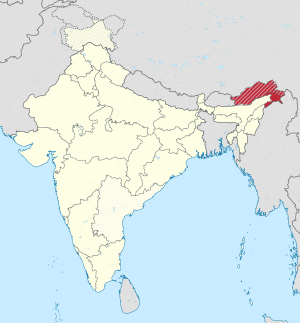1987 Sino-Indian skirmish facts for kids
Quick facts for kids 1987 Sino-Indian skirmish |
|||||||
|---|---|---|---|---|---|---|---|
 The 1987 Sino-Indian skirmish occurred between the two Asian giants, China and India. |
|||||||
|
|||||||
| Belligerents | |||||||
| Commanders and leaders | |||||||
The 1987 Sino-Indian skirmish was a short but tense event between two large countries, China and India. It happened in the Sumdorong Chu Valley in the middle of 1987. This was not a full war, but more like a serious standoff between their armies.
This event was the second time China and India had a military conflict. The first one, known as the Sino-Indian War, happened exactly 25 years earlier in 1962. Both countries share a long border, and some parts of it are still disputed, meaning they don't agree on who owns the land.
Contents
Where the Standoff Happened
The Sumdorong Chu Valley is a remote area located in the Arunachal Pradesh region. This region is in the northeastern part of India. However, China also claims this area as its own territory.
Because of these disagreements, the border between China and India is not clearly marked everywhere. This can sometimes lead to soldiers from both sides ending up in areas the other country believes is theirs.
What Caused the Skirmish?
The main reason for the 1987 skirmish was a disagreement over who controlled the Sumdorong Chu Valley. Indian officials believed that soldiers from China's army, called the People's Liberation Army (PLA), had moved into Indian territory.
This movement of troops was seen as an invasion by India. It quickly raised tensions between the two powerful nations.
The Standoff Begins
In 1986, some Chinese soldiers set up a camp in the Sumdorong Chu Valley. India saw this as a direct challenge to its control over the area. In response, India sent its own soldiers to the valley.
The Indian army, led by General K. Sundarji, moved quickly to face the Chinese troops. Both sides were very close to each other, creating a very tense situation. It seemed like a full-scale war could start at any moment.
What Happened Next?
Despite the high tension, neither side wanted a full war. Both China and India began to talk to each other through diplomatic channels. This means their governments communicated to try and solve the problem peacefully.
After a period of intense discussions, the Chinese People's Liberation Army eventually agreed to withdraw from the Sumdorong Chu Valley. This was a peaceful end to the standoff. It showed that both countries could resolve their differences without fighting a major war.
Why This Event Matters
The 1987 Sino-Indian skirmish was important for several reasons. First, it showed that border disputes between China and India were still a serious issue. Even after the 1962 war, the border remained a source of tension.
Second, it proved that both countries could use diplomacy to prevent a small conflict from becoming a big war. This was a positive step for their relationship. It helped them set up ways to talk and manage future border issues more peacefully.
The event also highlighted the importance of clear border lines. It encouraged both nations to work towards better understanding and communication along their shared border.
Images for kids


